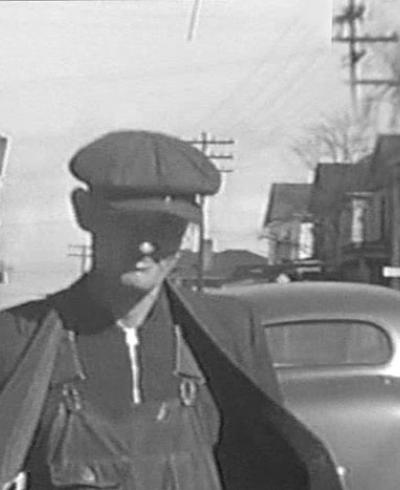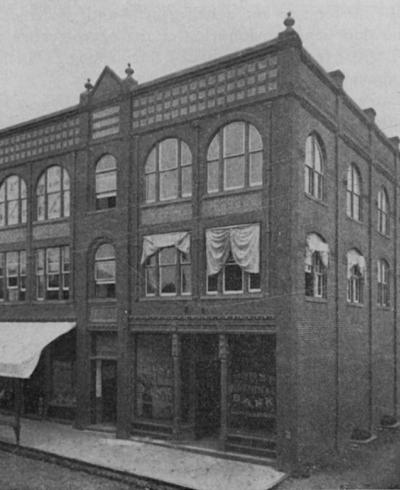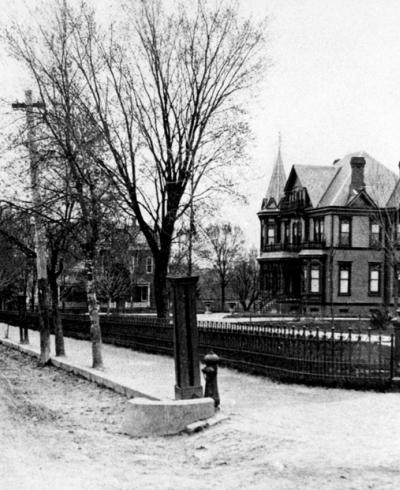From the NC Architects website:
Byron A. Pugin (1844-1909), architect, designed several important buildings in Durham in the late 1880s, worked briefly in Seattle around 1890, and established a practice in Atlanta that continued from the early 1890s until his death in 1909. His life story is a mysterious one: he does not appear in any known records until the mid-1880s, when he was in his forties, and, most intriguing, he may have been the illegitimate son of the famous English architect Augustus Welby Northmore Pugin.
Like many builders and architects of the late 19th century, Byron A. (Augustus?) Pugin moved frequently as he pursued work in cities booming after the Civil War. His obituary said he came to the United States shortly before the Civil War and served as a cavalry officer in the war. However, no evidence of his military service has been found, and his widow's war pension application was rejected. He said that he had worked in Virginia and designed a chapel at the University of Virginia before coming to North Carolina. Although he did marry his wife, Jennie Lind Collins, in Virginia in 1885, no mention of his work has been found in the university's records. His first known works are in Durham, North Carolina.
In the young railroad and tobacco town of Durham, Pugin found a perfect market for his skills in a community bursting with tobacco money and recovering from recent fires. Few of the self-made men who led the town's growth were likely to ask questions about a newcomer's background as long as he met their needs. Pugin's architectural skills quickly gained him commissions from Durham's newly wealthy industrialists. For pioneer tobacconist E. J. Parrish he designed the ornate and imposing E. J. Parrish Store on Mangum Street, which was followed by other stores. Still more prestigious jobs included the Benjamin N. Duke House in lavish Queen Anne style for a member of the city's leading tobacco manufacturing family, and the (first) Durham County Courthouse, an eclectic brick building with mansard tower. Although these were some of Durham's most outstanding buildings of their day, none has survived. Some of Pugin's buildings in Durham were constructed by contractor Charles N. Norton. Whether the two knew one another in Virginia before coming to Durham is unknown.
According to an article in the August, 1896 issue of Southern Architect, Pugin (who by then was in Atlanta and designer of "fine residences" in that city), had "also designed the residences of Messrs. Benjamin and Washington Duke, at Durham, N.C., each costing $50,000, and the residence of Mr. Julian S. Carr, in the same city, which cost over $100,000, and other buildings in different parts of the country." The Washington Duke House (1880s), built for the father of Benjamin N. and James B. Duke, has been credited to architect George F. Barber, but it is possible that Pugin also had a role in its construction. The architect of Somerset Villa, the luxurious Queen Anne style residence built for tobacco and textile magnate Julian S. Carr from 1887-1888, was John B. Halcott of Albany, New York, and here too perhaps Pugin was involved in a minor role, or perhaps he was stretching his Durham story a bit.
After a few years in Durham, Pugin was on the move again. In 1890 Byron A. Pugin appeared in the Seattle city directory as an architect. By 1893, he moved to the burgeoning city of Atlanta, and he was listed as an architect in that city's directories from 1894 to 1909, the year of his death. He took part in the 1895 Cotton States Exposition. He also planned numerous other buildings and was involved in a few controversies in the New South capital of Atlanta. In 1900 he was listed as head of household with his wife Jennie, a native of Virginia, and three children--Welby N. and Mary B. (born in 1886 and 1888, respectively, in North Carolina) and Darrell, born in Georgia in 1893. These were Byron Welby Northmore Pugin (1886- 1961); Mary Burns Pugin (1888-1989); and Ezra Darrell Pugin (1893-1963). Another child, Jennie Lind Pugin, named for her mother, was born in 1891 and died in 1892.
Besides his architectural accomplishments in Durham and Atlanta, Byron A. Pugin is of special interest because of the hypothesis that he was the illegitimate son of the internationally famous English architect Augustus Welby Northmore Pugin (1812-1852). The story is a credible one. Byron A. Pugin, as noted earlier, did not appear in records by that name until 1885, when he was over forty. He reported to the census taker of 1900 in Atlanta that he had been born "at sea" and that his father was English, his mother Scottish. Byron Pugin's death certificate in Georgia did not give the names of his parents. A possible scenario is that he was sent to America--or perhaps to another country--as an unborn child with his mother or as a small child with his mother or someone else and spent his early years under a different name before assuming the name of Byron A. Pugin. Especially telling, Byron named his first son Byron Welby Northmore Pugin, and called him Welby (Augustus Welby Northmore Pugin was generally called Welby, not Augustus). Byron's daughter, Mary Burns Pugin, who lived to be more than 100 years old, traveled to England in the 1920s and met some of the English Pugins, who did not credit any familial relationship.
Welby N. Pugin (1886-1961) trained with his father in 1904-1906, became an architect, and moved to Nashville, Tennessee, where he registered for the draft during World War I, giving his full four names (Byron Welby Northmore Pugin). According to a Tennessee account, "Welby N. Pugin was born Aug. 18, 1886 in Durham, North Carolina. His father, Byron A. Pugin, was an architect and was a native of France. Welby was named for his great uncle, the famous English architect." The uncle relationship is unlikely, for A. W. N. Pugin was an only child.
The American family believes that the connection is a likely one. Pugin's biographer, Rosemary Hill, has noted that in 1843, when Byron Pugin was probably conceived, the elder Pugin's marriage was a troubled one, and records of this year in his life are missing. Based on her detailed study of A. W. N. Pugin's papers, Hill finds it possible though unproved and probably unprovable that Byron A. Pugin was the natural son of A. W. N. Pugin. If he was not Pugin's kin, however, Byron Pugin was an unusual imposter: someone possessed of sufficient family knowledge to fabricate a heritage of distinction, but who did not overtly claim that heritage.





Add new comment
Log in or register to post comments.